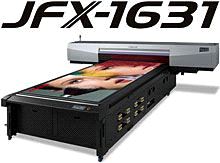LFP - Large-Format-Printing
Mimaki introduces the JFX-1631 – a fast, high quality large format UV LED curable flatbed inkjet printer

Monday 18. May 2009 - Today Mimaki Engineering Co., Ltd. (headquarters/Tomi City, Nagano Prefecture, President/Akira Ikeda) unveiled the JFX-1631 fast, high-quality large format UV curable flatbed inkjet printer incorporating the very latest in UV LED curing technology and high-precision linear microstepping.
For the past several years, Mimaki Engineering has been a pioneer in the inkjet printer industry with its UV inkjet technology. In 2004, the company started sales of the UJF-605C UV curing inkjet printer. This was followed in 2006 with the large format JF-1631/1610 and, in the fall of 2008 with the UJV-160 which employs LED curing technology. The fast, high quality JFX-1631 model now announced will be the top of the line flatbed inkjet printer model featuring latest technology implementations. This trend setting UV LED curing inkjet printer features a low power consumption UV LED curing system as well as enhanced image quality.
The new UV LED curing system drastically reduces the amount of generated heat, allowing the printer to support a broader range of heat-sensitive media, such as foam and channel boards, PVC, acrylic and styrene panels. The ink is instantaneously cured by ultra-violet rays irradiated from UV LEDs, thus totally eliminating the need for post-printing drying time necessary for solvent and other inks. This considerably improves job turnaround time. What’s more, this groundbreaking inkjet printer incorporates advanced functionalities. In addition it is eco-friendly. In comparison to conventional metal halide lamps** UV LEDs save 2/3 of energy. Furthermore, the lifetime of LEDs is five times as long as that of conventional UV lamps. Another decisive benefit of UV LED technology is the fact that UV LEDs do not need any warm-up time. They can be switched on and off whenever needed.
The JFX-1631 incorporates eight new print heads to achieve a print speed twice that of previous models. The new head positioning system uses high resolution linear motors for ultra fine step accuracy of dot placement. This results in far fewer banding artifacts and even the possibility to print legible three point type.
Two types of UV ink are available, flexible and hard, for a wide range of printing applications. White hard ink is also available to enable vivid full-color printing on transparent and colored materials.
In addition Mimaki is offering new workflow software which enhances productivity and efficiency even further.
Main Features
1. The new head positioning system uses high resolution linear motors for ultra fine step accuracy of dot placement even on large format media up to 1,602 mm (63.1″) x 3,100 mm (122″).
2. UV LEDs do not generate heat thus preventing thermal deformation of media.
3. Incorporates newly developed print heads to ensure twice the speed of its predecessor models.
4. Direct printing on non-coated media up to 50 mm thickness is made possible.***
5. Two types of UV inks are available, flexible and hard, for a broad range of printing applications.
6. White hard ink enables vivid full-color printing on transparent and colored materials.
7. Optional page feeding mechanism also enables high-precision printing on roll media. (start of sales scheduled for end of 2009)
“High-quality UV LED curing inkjet printers that use the latest UV LED curing technology provide the printing industry with a revolutionary new technology and enable new workflows thanks to advanced digital printing systems that will eventually replace conventional printing. Advanced UV LED curing technology also helps achieve low energy consumption and a work environment mostly free from VOCs (Volatile Organic Compounds) thus enhancing it even further”, says Kazuyuki Takeuchi, head of Mimaki’s IP Business Unit.
* Linear microstepping: This mechanism detects the position on the vertical axis to correct for any movement error.
** In comparison with Mimaki’s own metal halide UV lamps.
*** Depending upon the media a primer might have to be applied first.
